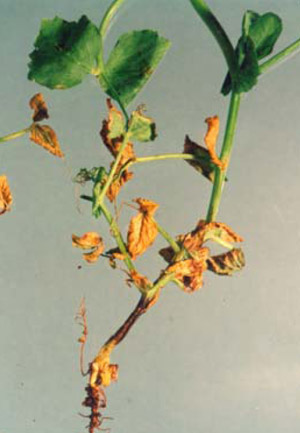|
Ascochyta collar rot disease is a major concern in pea production. Seed dressings offer some protection early in the life of the crop, but exposure to high levels of soilborne inoculum can lead to lower stem or collar rot infection later in crop development.
This three-year project, identified options for managing collar rot disease due to soilborne inoculum.
Three main areas of study were :
- development of a fungicide control program
- evaluation of late fertiliser applications on severely infected crops
- field inspections in commercial crops to identify factors contributing to collar rot disease incidence and severity.
Ascochyta disease has influenced pea production for as long as peas have been grown.
To guard against this disease, current industry practice is to use Apron and P-Pickel T as a seed dressing.
While this offers some protection early in the life of the crop, control is not always adequate, due to plant exposure to high levels of soilborne inoculum, leading to lower stem or collar rot.
Collar rot occurs on almost all pea crops after the expiry of the initial protective period provided by the fungicide seed dressings.
To date, there are no effective control measures for managing soilborne infections.
Authors
|
Hoong Pung
|
Susan Cross
|


Conclusions :
-
Studies showed that high spray volumes result in little or no reduction in collar rot severity, when compared to standard practice.
-
In crops with severe collar rot disease, early foliar treatments of Bravo 720®, using low to moderate spray volumes, reduced the severity but not the incidence of collar rot, improving plant growth and increasing pea yield.
-
However, no improvement was apparent in crops that had only mild to moderate collar rot.
-
Bravo, a relatively low cost product, is already registered for use on peas for downy mildew control.
-
Shirlan, applied at a high rate, also reduced collar rot severity and improved plant growth, although at lower rates, it had little or no effect and is not considered to be economical to the pea industry.
-
Copper hydroxide, the only product currently registered for Ascochyta control on peas, was found to be ineffective against collar rot in this project.
-
Other products evaluated in this project, including Impact, Calixin, Oxine, AgriFos and Rovral, did not reduce collar rot severity.
-
Late nitrogen or fungicide applications did not improve severely diseased plants in field trials.
-
All treatments with post-emergent herbicide sprays increased collar rot severity when compared to the untreated control.
However, pre-emergent herbicides Command and Frontier gave good weed control with good plant tolerance, and did not appear to influence collar rot severity.
-
Field inspections were conducted on commercial crops in 1997 and 1998 to identify field factors that may contribute to severe collar rot infection.
This knowledge could be used to assist with ground selection, and to identify areas that are prone to severe collar rot, where the use of Bravo would be beneficial.
-
An information booklet on collar rot management has been published and distributed to growers, field officers and other representatives of the processing pea industry.
-
Project findings have also been presented at conferences, and at field and extension days, throughout the life of the project.
Acknowledgments :
The research contained in this report was funded by the Horticultural Research & Development Corporation, with the financial support of:
- Processing pea growers
- Crop Care Australasia Pty Ltd
- ISK Oceania Pty Ltd
- WAFF Processed Vegetable Growers Association
The Australian Government provides matched funding for all HAL’s R&D activities.
|

